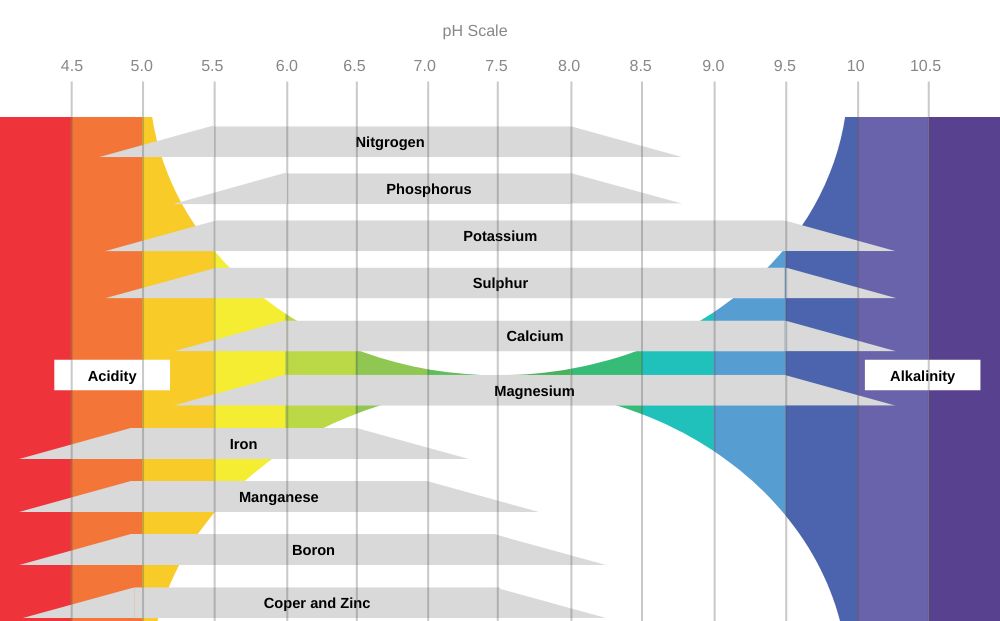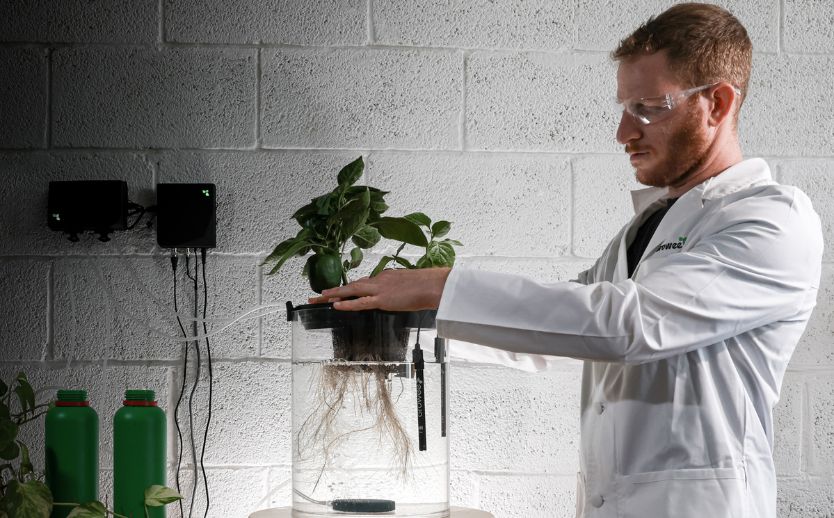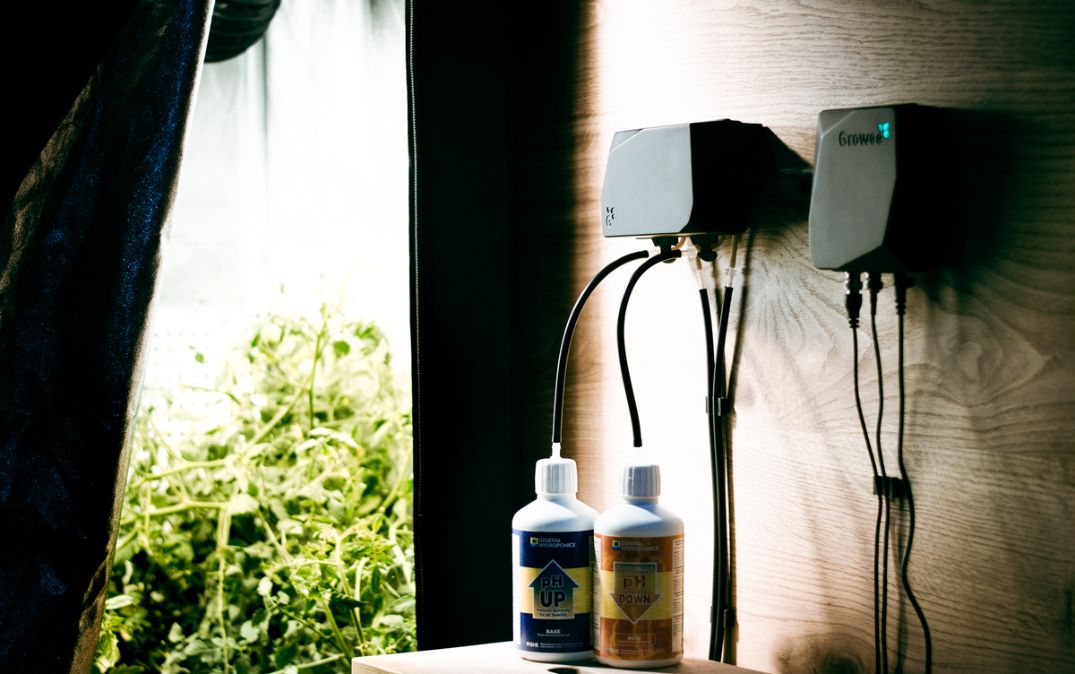Over the last few years, there has been a growing interest in hydroponics as more people begin to appreciate the many benefits it has for DIY home gardeners.
However, there is still a lot that needs to be done in terms of educating people on the basics of setting up and running a hydroponic garden. The level of supervision and control that is required is something a lot of people are not used to.
That is why many forward-thinking companies, such as Growee, have developed an exceptional product, controlled from anywhere by an App that will make controlling all the various parameters of a hydroponic setup much easier and even autonomously !!!
One parameter, in particular, which needs to be carefully monitored at all times is the pH. Plants are very sensitive to pH changes, especially when they are growing in a 100% water environment.
If you have been struggling with controlling the pH levels in your hydroponics system, you have come to the right place.
Growee has developed a state-of-the-art system that allows you to easily monitor and control the pH of your water and other parameters.
Read on to find out more!
See How Growee Can Save You Time By Automating Your Plants Feeding
Water pH – Automated pH Up and Down Control
Nutrients Mixing – Automated Nutrient Dosing with Target EC / PPM Control.
Control From Anywhere – WiFi Connection and mobile App
What Is pH?
The pH of a liquid is the measure of its alkalinity or acidity using a scale of zero to 14, with zero being extremely acidic and 14 being extremely alkaline.
A liquid has a specific pH that differentiates it from other types of liquids and allows it to interact in a certain way with other compounds. In hydroponics, it is the pH of water that we are mainly concerned with.
The pH of rainwater, for example, will be very different from that of either tap water or osmosis water. PH can be adjusted by adding either acidic or alkaline substances ,simply called PH up and PH down, into the water until the desired pH level has been achieved.

Why pH Is Important in Hydroponic Systems?
Plants are extremely sensitive to pH levels and any deviation from their normal ranges will result in a reduction in nutrient uptake.
This means you can have all the necessary nutrients added to your osmosis water but still notice your plants showing signs of nutrient deprivation, such as yellowing of leaves, stunted growth, and poor flower and fruit development.
Even in soil agriculture, where plants have the assistance of microorganisms, organic matter, and soil minerals, maintaining proper levels of pH is important. What more in hydroponic systems where the plants are directly submerged in the water medium? PH regulation becomes of vital importance.
Typical PH Ranges for Crops
Most plants grow best in acidic environments, which usually have a pH of around 5.5-6. Tomatoes, squash, beans, apples, and melons are examples of fruits and vegetables that grow well in this pH range.
A few plants prefer even lower pH ranges of around 4-5, such as blueberries. When growing plants with different pH requirements, it is a good idea to group them according to their specific pH and provide each group with a separate nutrient reservoir.
On the other end of the scale are those plants that thrive in very alkaline conditions of around 7-8, such as Mint plants. Pumpkins have a wide range of pH tolerance, from 5.5-7.5. Other plants are close to the mid-range to slightly alkaline pH level, such as peas, onions, and kale.
[Learn More]: Best Plants to Grow Hydroponically

Typical pH Ranges for Nutrient Systems
When formulating the ideal pH for your hydroponic system do not use the required pH for plants growing in soil as this will not apply here. Since the optimum pH level for most crops is around 5.5-6, this would be a good place to start.
Various chemical compounds can be used to adjust the pH levels, such as nitrate, ammonium nitrate, and calcium salts.
Very low pH levels of less than five will result in poor uptake of minerals, while on the other hand, any pH of above 6-6.5 may cause iron deficiency in most plants.
Why pH Levels Change in Hydroponics Systems
The following are some of the factors that result in significant changes in the pH of water in hydroponic systems:
- Nutrient Solution Level
As your plants grow, they will use up a lot more water than they do nutrients. This will result in a gradual lowering of the water level which will leave behind a very concentrated nutrient solution.
If not kept in check this can endanger your crop.
One way to guard against this is to always make sure the reservoir is kept full or at a traceable, constant level and to monitor the pH levels regularly.
- Inorganic and Organic Matter
Some matter that is either added to the hydroponic system or is produced by the growing plants called exudes can affect the water quality, which makes it difficult for you to adjust the pH or obtain accurate readings.
It is important to take the pH reading of the nutrient solution as it goes into the system as well as the leachate that comes out. This will give you a good idea of the effect of organic and inorganic matter’s influence on the pH of your water.
- The Action of Algae and Bacteria
Bacteria and algae are the main types of organic matter responsible for changes in the pH of your liquid medium. Even if you use reverse osmosis water that is free from any microorganisms, they will still be introduced from the environment.
Algae will consume carbon dioxide during the day, which increases the pH.
Bacteria from naturally rotting roots, stems, and leaves will also cause the pH to fluctuate unpredictably.

How To Maintain the Right pH Levels
A huge chunk of the work that you will do to keep your hydroponic system running smoothly has to do with maintaining the right pH levels.
The following tips will help you:
- Test pH Regularly
Regular testing of pH is an absolute must in hydroponic systems. The sooner you can catch the deviation from optimum levels, the easier it will be to make readjustments.
Plants that have been exposed to extreme pH conditions for a long time will take a long time to recover and in some cases may go into what’s called “nutrient lockout”, and may not recover at all.
- Maintain proper Levels of Nutrient Solution
The easiest way for you to guard against pH fluctuations is to maintain the right level of nutrient solution.
This means ensuring proper nutrient solution circulation is maintained.
You may have the right level in your reservoir but the water in direct contact with your plants may have become contaminated with organic matter, which has altered the pH.
- Use pH Up and pH Down Solutions
There are many commercially available pH adjusters known as pH up and pH down solutions. These can be purchased in either solid or liquid form but must be used according to the manufacturer’s instructions.
You need to make sure you purchase solutions that have been specifically formulated for use in hydroponic systems. A proper pH up or down solution is the best option, whatever the size of your grow.
- Automatic pH Adjusters
Although a lot more expensive than simply adding pH up and pH down solutions, using automatic pH adjusters is the best option if you have a fairly large, recirculating hydroponic system.
Using automatic pH adjusters will allow you to quickly fix any pH fluctuations before they have had a chance to affect your plants. If you are using hard water, it is better to run it through a reverse osmosis filtration system first, to reduce the water hardness that will likely affect the performance of your pH adjusters.
Benefits of Measuring and Maintaining pH Levels
The following are some of the main benefits of maintaining the right pH levels in your hydroponic system:
- Quickly pick up pH deviations
- Maintain proper levels of nutrient uptake
- Protect plants from the negative effects of extreme pH and potentially go into “nutrient lockout”
- Maintain optimum plant growth, flowering, and fruit formation
Setting up Your Hydroponic System Correctly
If you can get the pH requirements right, you will be well on your way to becoming a successful DIY hydroponics farmer. However, measuring and maintaining the proper pH levels is easier said than done.
Considering the potential damage, the wrong pH can have, it is worthwhile to invest in an automatic pH adjuster.
If you are looking for an affordable, high-quality automatic pH controller, at Growee, we have exactly what you need. Take advantage of our pH combo and get the smart pH Balancer and Hydro Master: Real-time pH and EC monitoring from anywhere with the Growee App, set up your desired pH range and Growee will keep it in range 24/7.
Growee Hydroponics Controllers gives You EXTREME Control anytime, anywhere. Don’t let your plants suffer any longer. Grab one of our automatic pH adjusters and never have to worry about constantly keeping an eye on your hydroponic system.
FAQ
How Do You Keep a pH Stable in Hydro?
There are a few tried and tested ways that you can use to keep your pH stable, which are:
- Maintain the right levels of Nutrient solution
- Regularly test pH throughout the day
- Use pH up and pH down solution
- Install an automatic pH adjuster
Why Does My pH Keep Rising in My Hydroponics?
There are a few different things that can cause your pH to rise.
Firstly,as the plant consumes the nutrients and produces exudes from the roots into the water , this alone changes PH levels. If it happens during the day, it could also be due to the effect of algae.
Another reason could be the presence of inorganic material that is affecting the PH. You should also keep an eye on the nutrient solution level as this may cause pH fluctuation when left to fall below optimum levels.
How Do You Stabilize pH in a Nutrient Solution?
Depending on the quantity of the nutrient solution, you can use a variety of methods to stabilize the pH. The most common and affordable method is to use pH up and pH down solutions.
However, those with large-scale and continuously circulating hydroponic systems will best invest in an automatic pH adjuster for the best results.
How Often Should I Adjust pH Hydroponics?
One of the best things to do is to make as many adjustments as necessary, which means adjusting the pH whenever you see it out of range.
You can create a schedule for checking the pH, for example,at least twice a day due to constant fluctuation.
What Is the Best pH for Hydroponics?
The best pH for hydroponics is a range between 5.5 to 6.5 which allows the majority of plants to grow. This range is ideal for the optimum absorption of many of the 16 elements that plants require for growth.



